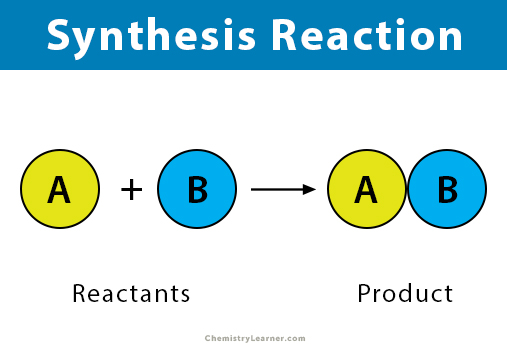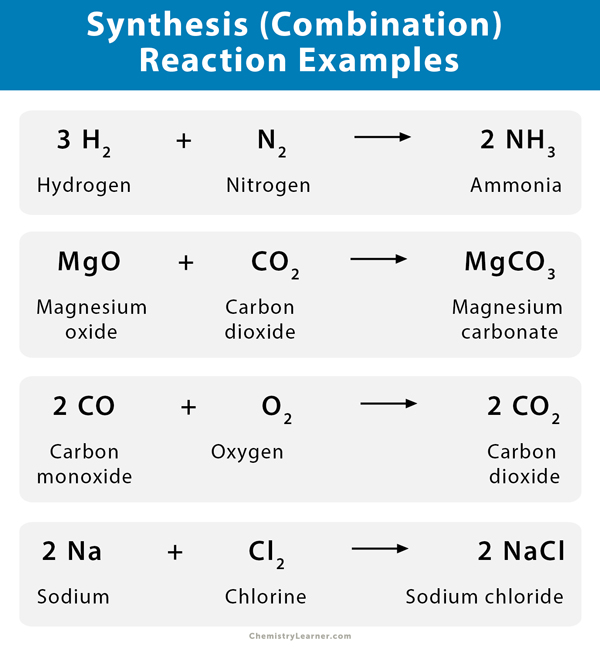Synthesis Reaction (Combination Reaction)
What is a Synthesis Reaction?
A synthesis reaction is a reaction in which two or more reactants chemically bond and combine to form a product. A synthesis reaction is also known as a combination reaction. Most synthesis reactions are exothermic reactions, i.e., heat is released during the reaction.
General Equation
The general chemical equation for a synthesis reaction is given by the following equation.
A + B → AB
When writing an actual reaction, the reaction must be balanced.
How to Identify a Synthesis Reaction?
A synthesis reaction combines all the reactants of the reaction to form a product. To recognize a synthesis reaction, look for a product that contains all the reactant atoms.
Example of Synthesis Reaction
An example of a combination reaction is the combination of aluminum (Al) and oxygen (O2) to aluminum oxide (Al2O3).
4 Al (s) + 3 O2 (g) → 2 Al2O3 (s)
Different Types of Synthesis Reaction
There are three types of synthesis reaction.
1. Reaction between two elements
Examples
- The reaction between hydrogen (H2) and nitrogen (N2) to form ammonia (NH3)
N2 (g) + 3 H2 (g) → 2 NH3 (g)
- The reaction between carbon (C) and oxygen (O2) to form carbon dioxide (CO2)
C (s) + O2 (g) → CO2 (g)
- When sodium (Na) metal reacts with chlorine (Cl2) gas, the reaction results in sodium chloride (NaCl), also known as common salt
2 Na (s) + Cl2 (g) → 2 NaCl (s)
- The reaction between iron (Fe) and oxygen (O2) results in iron (III) oxide (Fe2O3), commonly known as rust. Rusting is a naturally occurring phenomenon.
4 Fe (s) + 3 O2 (g) → 2 Fe2O3 (s)
2. Reaction between two compounds
Example
- When magnesium oxide (MgO) and carbon dioxide (CO2) combine, the resulting product is magnesium carbonate (MgCO3)
MgO (s) + CO2 (s) → MgCO3 (s)
3. Reaction between an element and a compound
Example
- The reaction between carbon monoxide (CO) and oxygen (O2) yields carbon dioxide (CO2).
2 CO (g) + O2 (g) → 2 CO2 (g)
Examples of Synthesis Reactions in Everyday Life
There are a few examples of the synthesis reaction in real and daily life. Almost all real-life examples are seen in the industry. During industrial production, the synthesis reaction plays a significant part in synthesizing new compounds.
- Synthesis of ammonia
- Commercial production of slaked lime (calcium hydroxide)
- Production of sodium chloride or common salt
- Preparation of hydrochloric acid and ammonium chloride
Other examples include
- Rusting
- Photosynthesis
FAQs
Ans. A decomposition reaction is one when a substance decomposes into two or more products. This reaction is the opposite of what a combination does.
Ans. Yes. In fact, most common oxidation-reduction (redox) reactions are combination reactions.
Ans. Yes, a combination reaction can be an oxidation reaction if one of the reactants is oxygen.
Ans. While all combination reactions are exothermic, there can be an exception. The production of nitric oxide (NO) from nitrogen and oxygen is an endothermic reaction.
Ans. Dehydration synthesis is the formation of larger molecules from smaller reactants, followed by the loss of a water molecule.
Ans. Dehydration synthesis reactions build up the molecules and generally require energy, while hydrolysis reactions break down the molecules and generally release energy. The two are opposite to one another.

